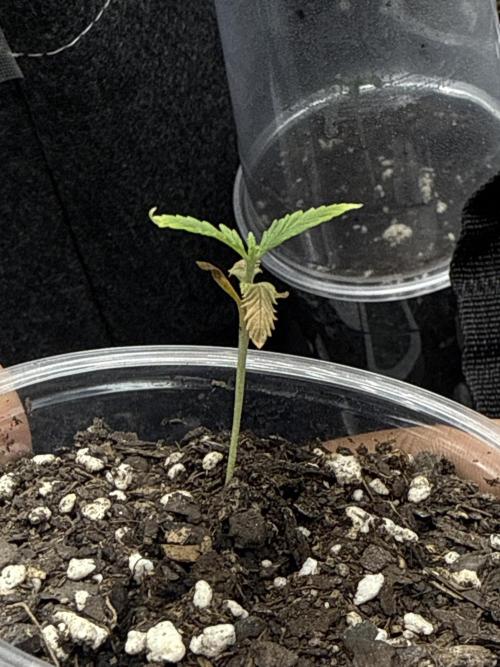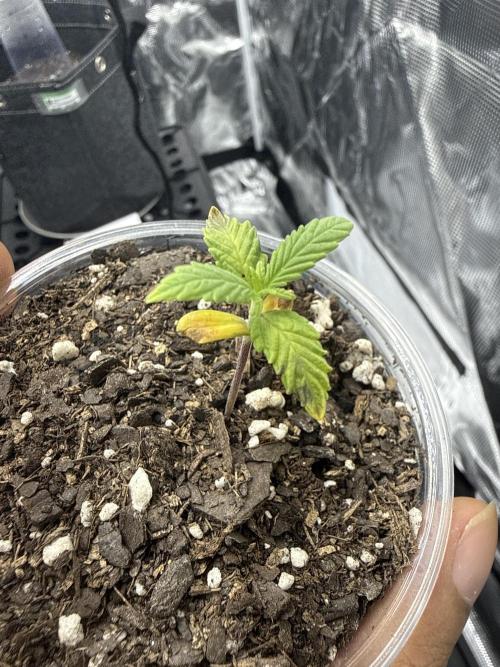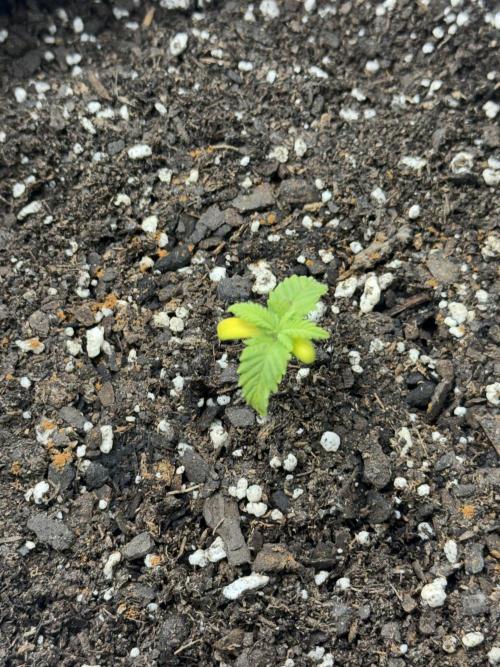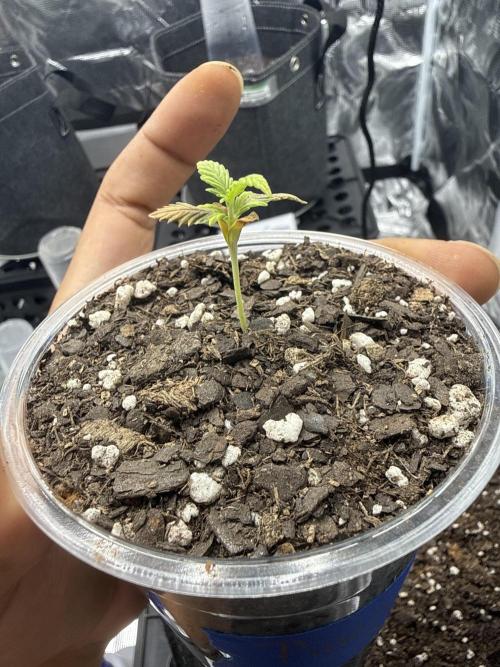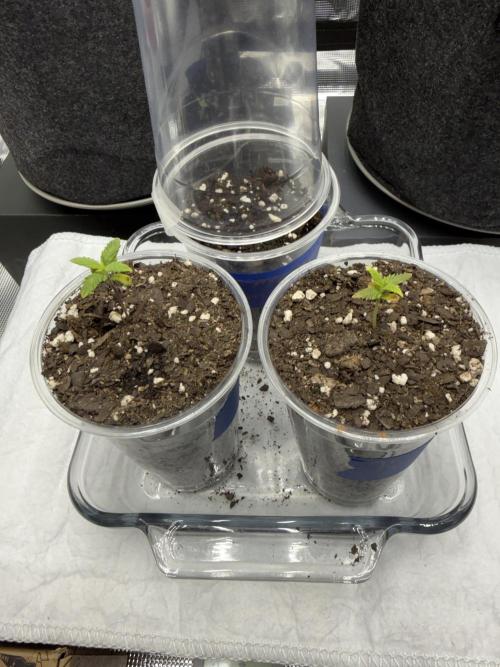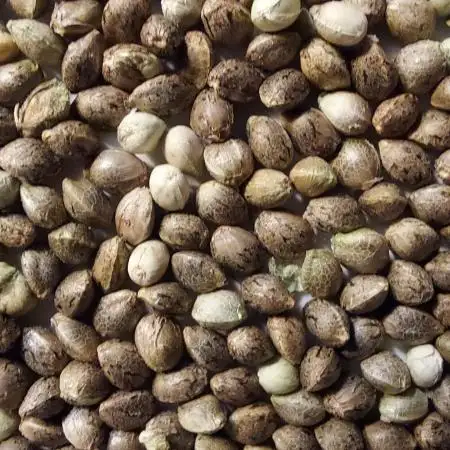The Grow Awards 2026 🏆 



























Sick seedling
Itshimleestarted grow question 2mo ago
I’m 15 days in an I’m not sure what I could be doing wrong, I’m thinking maybe overwatering or ph is off. They were under a 150w light the first 2wks, but have been under a 400w light @ 5% for the last week. Please help any tips
Also using fox farm happy frog
Open
Leaves. Tips - Burnt
Leaves. Curl down
Leaves. Color - Yellow
likes
Answer
CaliBoyTFanswered grow question 2mo ago
Friend, what’s happening is that since they’re in containers without drainage, you’re dealing with root rot. When the roots below the soil get damaged or start rotting, the plant shows it above ground — they’re like a mirror.
Water with a very small dose, keep the seedlings uncovered under gentle light, transplant them into opaque pots (since light hitting the soil can cause mold or algae in organic mixes), and most importantly, add mycorrhizae — any brand will do. They won’t just protect the roots; the microorganisms also use water to reproduce, which makes it harder for excess water to accumulate if you overwater again. I hope this helps you with this and future grows.
likes
Complain
Organomananswered grow question 2mo ago
Rooting/putrefecation from being cooked inside "humidity domes".
Seedlings do not need domes, they need air movement to strengthen stems and enable correct transpiration.
likes
Complain
John_Krameranswered grow question 2mo ago
Shitty soil, bad watering, looks like starving
likes
Complain
Fruitgroweranswered grow question 2mo ago
I would say it's the soil has too many nutrients, confusing the young root system. It's best to start seedlings off in a neutral medium with lots of perlite in to reduce over watering and the seed itself has enough nutrients to grow anyway until 3 weeks ish
likes
Complain
Green_clawsanswered grow question 2mo ago
Fox farm soil again killing seedling since 1984...
likes
Complain
m0useanswered grow question 2mo ago
FFHF can be hot, and your plants don't need a humidity dome. They are fine without it. Other good points brought up by numbers.
likes
Complain
I_T_C_R_W___GROWanswered grow question 2mo ago
pic2 - burned down - to much light ; check with app - not give more than 150 ppfd to a seedling - you need just 10 Watt at 20cm ! not 150 or 400!
water them with water (ph 6-6.3) , use a small lamp and feed them with water once a day a few ml to have the soil moisture but not wet arround it.
they can recover in a few days.
Even your windowboard would be ok in this state if there is some sun.
less - not more !
they cant handle any burn or heat streas anymore, a mini foger would be great now to have arround 60-70% to unstress them from transpiration needs, to build new leafs and recover.
And they cant handle any nutri stress now,too.
Just Water.
The soil has what she needs for at least a few days or weeks.
likes
Complain
00110001001001111Oanswered grow question 2mo ago
The best guides to read are on cocoforcannabis.com. Least amount of bro-science. Even calls out some of the more egregious nonsense. As well as help you learn how to assess and discern from anecdotal nonsense and useful information.
likes
Complain
00110001001001111Oanswered grow question 2mo ago
Looks like several possible problems...
First, let's tackle proper watering habits.
1) fully saturate -- anynone that says differently is retarded. If it is 'soilless' you also must get a minimum of 10% running out the bottom. That is waste water. don't let it sit in its own piss. That water is fine for an outdoor garden, but not a potted plant.
2) wait for appropriate 'dryback.' -- you can discern this by weight or depth of dryness. In a soil, let it dry about 1" deep before repeating. there is some leeway here, but stick to otrthodox until you can think on your own in regard to adjusting wet-dry cycle. If it's coco, it holds muchless per volume and you re-irrigate when the top starts to change color. The type of medium does impact this a bit, but if you go by weight, you'll quickly become familiar.
if "soilless", you must also fertilize ever single irrigation with a full, well-ballance diet. With soil, how often you fertilize will depend on how concentrated you mix as well as the soil products you use. Over time you need to supplement what gets exhausted. This is a trial and error learning process... if systematic, take notes about the deficiencies you see and when you see them... can better adjust your fertilizing ramp up next time.
Other note that is relative -- soil constitution. You have some sort of wood chunks and minimal perlite. Better to go with perlite or vermiculite to improve drainage than large wood chips. that stuff can rot and fuck up the pH or grow useless mushrooms in your pot. in a heavy soil, you want 50% of volume as perlite or vermiculite or similar.... in coco, which holds less water, you only need 33% of volume... when each is mixed to these rations, they have the same drainage and aeration properties, so there is no advantage to one or the other in this regard , if consitituted correctly. One of the ridiculous myths of coco's ill-perceived superiority, lol.
-----
Pic #3 - exhibits signs of receiving too much light. There is little to no spacing between the growth nodes. Sounds like you've already reduced the light. The resulting node spacing of new growth will help you adjust light intensity going forward... once mature, it'll be consistent, but until then, go easy and ramp up as you see stretch. Take notes on timing and you can better adjust next time. This is an ongoing theme, as you can tell.
-----
The yellow cotys this early and other issues seen on real leaves means that medium doesn't have much nutrients in it. you likely need to start fertilizing.
-----
ph-balance anything you dump into the pot -- after any fertilizer is added. in soil - 6.5-6.8 and soilless 6.0-6.2. That really has more to do with the typical fertilizers involved than specifically due to the medium itself. If using soilless/hydro products, shoot for 6.0. Whit disitilled vinegar (5% acetic acid) is cheap an readily avaialble. Likely have some in your home. Get some 3-5mL pipettes to easily dose it out per gallon mixed.
Any base or acid will work well. don't overpay for "ph-up" or "ph-down" products... end up paying 10x for the same shit... citric acid is a common ingredient on the ph-down.
---
strongly suggest you use the smaller light early on... after you pot-up and the plants take up more space to warrant it, bump up to the 400w at that time. It'll be easier to handle, probably save some watts, too.
Anecote: i've got some sprouts right now. The 150w XS1500 light is 20-22" away and at about 40%. I'm just trying to cover a 10x20 tray properly... a smaller area can use even fewer watts and get the light much closer. I'll adjust based on what i see... if they stretch, i'll increase light a bit... if they stay too tight and small, i'll reduce light a bit.... plant behaviour dictates everything and not the other way around.
likes
Complain
Similar Grow Questions
Solved

Snakeking
Outdoor grow Heat wave in early flowering!Heat wave again:(
What can i do ? In this situation?
The upper leaves became lighter green but the edge of leaves didn’t cruel upwards yet.
I put a fan and i will add another one because i think that clear plastice increases the temperature but i cant take it off for secu
Week 19
Leaves. Color - Yellow
1y ago
6
5
Solved

laberg
Why does my bottom leaf have brownish white tip and is cripsy?Was checking leaf temps all over and at the very bottom first 3 point fan leaf that she ever grew I noticed the center leaf crispy at the tip with some light green spots around it. The only other leaves that look like this are the single first true leaves. Thoughts?
3y ago
2
3
Solved

WeedDude
What cause the change of the leaftip color?Plant now about 2 weeks old. After transplanting from small Pot to 5 Liter Pot Size and place under the MarsHydro TSL2000 with 50% lightpower.
2cd Day under the light and in the Growtent, color of the tips change (see pictures).
I would appreciate the help of an experienced growe
4y ago
2
2
Solved

TheFaeCat
Identifying the cause of stressDoes anyone know what I’m seeing with the leaves in these photos? The closest I’ve been able to guess from online resources is maybe sulfur deficiency, but to my eye it doesn’t seem to quite fit any of the broad categories. Perhaps just general under-fertilization?
Week 7
Leaves. Color - Yellow
2y ago
2
1
Solved

jbirdstheword
Browning spots after H202 rinse.Hey guys! My first dwc and I’m having an issue. So after about a week my water was cloudy. I rinsed and washed the bucket, fixed the area where light was getting in. Then I rinsed my cube and plant with H202 3%, 1/3 to 2/3 water. Changed out nutes but now look like this. ?
Leaves. Color - Yellow
Leaves. Color - Dark-brown
3y ago
2
3
Solved

PiusWaxis
foglie malate!Non capisco che problema possa avere! aiuto!Week 6
Leaves. Curl down
5y ago
2
2
Solved

KOKOK
Help my plantHey, i see something wrong with my plant, untill Day 10 she was under the cfl lamp n every thing was ok, at the Day 11 i switched the light to LEd and this happend:(
İ noticed when i compare the photos of the day 11 with Day 10, please help me im nervous, Thanks.
What you think?5y ago
3
3
Solved

Seldom_Seen
Possible nutrient burn ?I’m pretty sure this is nutrient burn but it’s weird because I’ve only given a tiny dose of nutrients so far. Less than a quarter of recommended dose and probably less than I’ve ever given an auto before. What do people think ? Nutrient burn ?
Week 3
Leaves. Tips - Burnt
3y ago
8
5
Solved

Hazeterpz
First time coco growerHello guys, first time growing in coco I’ve been feeding them 0,7 until now at 5.8 ph and today I added 1.2 ec and the runoff was 5,6. It’s been 3 weeks now and they’re not growing that well I’ll feed 6,5 next feeding. Can someone tell me if this is a calmag deficiency ?Anytips?
Leaves. Curl down
Leaves. Color - Yellow
Feeding. Deficiences
5y ago
5
6
Solved

ganjermaster
Burnt, should I throw it and start from zero?I have 1 burn auto for excessive light, should I throw this one and start from seed again or maybe flipping to 12/12? The light is farther now but maybe I can do something else than put away my lights.. my current schedule is 18/6 and the plant is around 45-50 days old
Leaves. Curl down
Leaves. Color - Yellow
Plant. Twisted
5y ago
1
6
Solved

I_am_him
I need help troubleshooting weak plants! I think the clover might be the culprit but what do I do?Can anyone tell me what’s going on with these plants and what I can do? This is my first grow. I can already tell the seeds are growing slow because other seeds I planted in smaller pots are growing much faster. Any advice would be greatly appreciated!
Leaves. Curl down
Leaves. Color - Yellow
Plant. Stem - Weak
4y ago
2
Solved

PurpleFingers
Too much nitrogen/water?I am having some trouble with a Sundae Driver phenotype. I have had this problem before and couldn't figure it out and thought I had corrected it with this grow by significantly reducing nutrients - currently on 3ml Canna A+B 1/3ml/l pk and 2 ml boost. Drinking 3-4l every 48hr
Week 6
Leaves. Curl down
6y ago
3
4
Solved

Grileon
Leaves curling down, light green colorHi everyone, have to strains in the same box and conditions. Same nutrients and water.
One seems to have some problem, leaves curl down and look light green color. Roots look healthy and white.
What could be the problem and how can I fix it?
4y ago
3
Solved

ChitownCannaChica
Auto flowers bottom fan leaves turn yellow—- cause and defoliation?My plants are about week 3 into flower and the bottom fan leaves are Turing yellow and dying out—- is this normal? Should I defoliate these off an auto during flower? How to correct???
Week 6
Leaves. Color - Yellow
5y ago
4
3
Solved

BullWeedDog
que puede ser esto en las puntas de mis hojasen las puntas de mis hojas de los brotes nuevo he notado algunas de un color mas claro o incluso en algunas las puntas quemadas que puedo ser esto???
Leaves. Color - Yellow
Other. General questions
Plant. Wilting
4y ago
1
1

